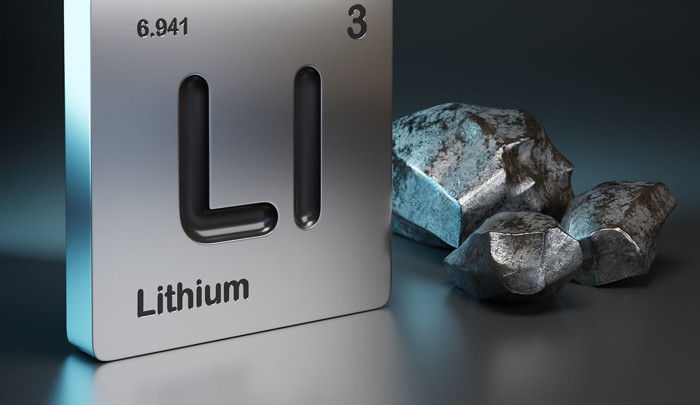What Is Lithium?
Learn more about lithium "the white gold": Unveiling its origins, characteristics, and applications.
Introduction
Lithium, a versatile alkali metal, has captured worldwide attention due to its remarkable properties and diverse applications. From being the lightest metal to powering our electronic devices and electric vehicles, lithium has revolutionized multiple industries. In this blog post, we will explore the origins of lithium, its various forms, extraction methods, environmental considerations, and its wide range of applications.
Table of contents:
Defining Lithium: A Light and Reactive Element
Lithium is a highly reactive alkali metal with the atomic number 3 and the symbol Li on the periodic table. Lithium is a remarkable silvery-white to grey alkali metal with distinct characteristics and properties. It is the lightest metal and has excellent electrochemical properties. Due to its low atomic weight and strong electronegativity, lithium is able to store and release electrical energy efficiently. Freshly exposed lithium has a metallic luster but quickly tarnishes when exposed to air, turning dull, silvery-grey, and eventually black.
Like other alkali metals such as sodium, potassium, rubidium, and cesium, lithium is incredibly soft and even softer than talc on the Mohs scale. This softness enables it to be easily cut with a knife. In its elemental form, lithium exhibits reactivity with water, although with less energy than other alkali metals, making it potentially explosive. It is also flammable in the presence of oxygen and can ignite when exposed to moist air. However, it is important to note that lithium does not occur naturally in its pure elemental form but rather exists in the wild as a non-flammable compound.
As a member of the alkali metal group, lithium is known for its high reactivity. It tarnishes rapidly in the air due to lithium oxide and lithium nitride formation. When subjected to pure oxygen, it burns with a bright red flame at 180 degrees Celsius, forming lithium oxide. Moreover, lithium demonstrates a strong reaction with water, resulting in the formation of lithium hydroxide.

Different Forms of Lithium
Global lithium production involves various methods that yield different types of lithium compounds. Common variants include lithium carbonate, hydroxide, lithium chloride, butyllithium, and lithium metal. These compounds find applications in numerous industries, particularly in the production of batteries, including lithium-ion batteries that power portable electronics, electric vehicles, and renewable energy storage systems.
Lithium exists primarily in the form of compounds in nature. The most common variants produced globally include:
Usage |
|
|---|---|
| Lithium carbonate | Widely used in lithium-ion batteries and pharmaceuticals. |
| Lithium hydroxide | Important for battery production, ceramics, and lubricants. |
| Lithium chloride | Utilized in air conditioning systems and as a catalyst in organic synthesis. |
| Butyllithium | An organolithium compound used in chemical reactions and as a polymerization initiator. |
| Lithium metal | Valuable for specialized applications, including lithium batteries and alloys. |
Usage
Lithium Deposits and Extraction Methods
Lithium deposits are found in various regions worldwide, with significant reserves located in South America, Australia, and China. Let's explore the different types of lithium deposits and the extraction methods associated with them:
It's important to note that the choice of extraction method depends on factors such as the type of deposit, ore grade, economic viability, and environmental considerations. Each method has its advantages, challenges, and associated environmental impacts.
-
Lithium Brine Deposits
Lithium-rich brine deposits are a major source of lithium production, particularly in South America. These deposits are formed by accumulating lithium-rich brine in closed basins over geologic time. The brine typically contains lithium salts dissolved in underground aquifers. Extraction from brines primarily occurs from continental brine deposits, but extraction from geothermal and oilfield brines has gained much attention in recent years.
Extraction Methods:
- Evaporation Ponds: Brine is pumped into large evaporation ponds in regions with favorable climate conditions. Sunlight and natural evaporation cause the water to gradually evaporate, leaving behind concentrated lithium salts. The concentrated brine is then processed further to extract lithium compounds.
- Direct Lithium Extraction (DLE): This method involves pumping brine directly from underground aquifers and using specialized technologies to extract lithium selectively. DLE techniques, such as selective ion exchange or adsorption, can help reduce the time and water required for lithium extraction. Learn more about Direct Lithium Extraction technology.
-
Lithium Hard Rock Deposits
Hard rock deposits, also known as pegmatite deposits, are another significant source of lithium. These deposits contain minerals such as spodumene, petalite, and lepidolite, which are rich in lithium.
Extraction Methods:
- Traditional Mining: Hard rock lithium mining involves conventional mining techniques, including drilling, blasting, and crushing, to extract the ore containing lithium-bearing minerals. The extracted ore is then processed through various physical and chemical methods to obtain lithium concentrates.
Environmental Implications
While lithium has immense value in the clean energy transition, its extraction and production can have environmental consequences. Issues such as water scarcity, habitat disruption, and chemical pollution need to be addressed through sustainable mining practices and responsible waste management. Additionally, efforts are underway to develop recycling technologies to minimize the environmental impact of lithium batteries.

Lithium Applications
From advanced lithium-ion batteries to grid-stabilizing energy storage, delve into the transformative role of lithium in our renewable energy future.
Lithium, the remarkable alkali metal, has revolutionized energy storage and beyond. Its applications are vast, from lithium-ion batteries powering our devices to driving the rise of electric vehicles. But the influence of lithium extends beyond portable electronics, finding its place in renewable energy storage, aerospace, and medical devices. Join us as we uncover the diverse applications of lithium, exploring its advantages, environmental impact, and pivotal role in shaping a sustainable future.
-
Lithium-Ion Batteries
Lithium is extensively used in rechargeable lithium-ion batteries.
Advantages:
- High energy density: Lithium-ion batteries offer higher energy density than other battery technologies, enabling longer-lasting power and increased device runtime.
- Lightweight: Lithium's low atomic weight contributes to the lightweight nature of lithium-ion batteries, making them suitable for portable devices and electric vehicles.
- Fast charging: Lithium-ion batteries can be charged quickly, reducing charging times and improving convenience.
- Minimal memory effect: Lithium-ion batteries exhibit minimal memory effect, allowing for more efficient charging and discharging cycles without significant capacity loss.
From Batteries to Electric Vehicles: The Importance of Lithium Extraction
-
Electric Vehicles (EVs)
Lithium-ion batteries are the preferred choice for electric vehicles.
Advantages:
- Extended driving range: Lithium-ion batteries provide the energy density required for electric vehicles to achieve longer driving ranges between charges.
- Rapid acceleration: Lithium-ion batteries offer high power output, enabling electric vehicles to deliver quick acceleration and improved performance.
- Environmentally friendly: Electric vehicles powered by lithium-ion batteries produce zero tailpipe emissions, contributing to reduced air pollution and greenhouse gas emissions.
-
Renewable Energy Storage
Lithium-ion batteries are crucial in storing energy generated from renewable sources like solar and wind.
Advantages:
- Smoothing energy supply: Lithium-ion batteries provide a means to store excess energy during periods of high production and release it during low generation, ensuring a consistent power supply.
- Grid stabilization: Energy storage systems using lithium-ion batteries help stabilize the electrical grid by balancing supply and demand fluctuations.
- Increased renewable energy integration: Lithium-ion battery storage enables higher integration of renewable energy sources into the grid, promoting the growth of clean and sustainable energy systems.
-
Portable Electronics
Lithium-ion batteries are widely used in various portable electronic devices such as smartphones, laptops, tablets, and smartwatches.
Advantages:
- Compact and lightweight: Lithium-ion batteries offer a high energy density in a compact and lightweight form factor, making them ideal for portable electronics.
- Longer battery life: The energy storage capacity of lithium-ion batteries allows for extended battery life, reducing the need for frequent recharging.
-
Aerospace and Aviation
Lithium-based batteries are used in aerospace applications, including spacecraft, satellites, and aviation equipment.
Advantages:
- Weight reduction: The lightweight nature of lithium-based batteries helps reduce the overall weight of aerospace systems, contributing to fuel efficiency and extended flight range.
-
Medical Devices
Lithium-ion batteries are used in various medical devices, such as pacemakers, defibrillators, and implantable medical devices.
Advantages:
- Long-lasting power: The high energy density and longer battery life of lithium-ion batteries ensure the reliable and continuous operation of medical devices over an extended period.
-
Other Applications
Lithium finds applications in ceramics, glass, lubricants, greases, heat-resistant materials, and pharmaceuticals, among others.
Lithium: Essential for Green Energy
Lithium, the lightest metal on Earth, is indispensable for the future of clean energy. Although it constitutes just 0.002 percent of the Earth’s crust, lithium’s unique properties make it essential for the energy storage solutions that underpin the global transition to renewable energy and electric vehicles.
Critical Role in the Green Energy Transition
The shift to clean energy technologies requires a significant increase in the use of critical minerals compared to fossil-fuel-based counterparts, with lithium at the forefront. The ability to store energy is crucial for the green energy transition. The combination of low weight and high energy storage density makes lithium the perfect material for batteries. As the world moves away from fossil fuels, the demand for lithium will continue to soar, making it a critical material in the fight against climate change.
Securing a Sustainable Future with Abundant Resources
The importance of lithium has been recognized by major economies, with the U.S. and Europe designating it as a critical raw material vital for economic and technological stability. Fortunately, global lithium reserves are ample and can meet the growing demand with responsible and innovative extraction practices. This abundance ensures that lithium will play a central role in supporting the green energy transition, enabling a sustainable and resilient future for future generations.
In addition, securing the supply of critical minerals, including lithium, has become a focal point in the intensifying geopolitical competition between the West and China. The U.S. and the European Union are now prioritizing the diversification of lithium sources to reduce reliance on China and bolster their own domestic lithium-ion battery production. This race to secure lithium resources is crucial for the development of independent, sustainable battery value chains that will support their green energy transitions.
Toward More Sustainable Lithium Mining
At Lithium Harvest, we are committed to embracing a sustainable approach to lithium production, aligning with the principles outlined in this blog post. We recognize the growing demand for lithium and its vital role in advancing renewable energy and clean technologies. Our operations prioritize environmentally responsible practices, ensuring minimal impact on ecosystems and local communities.
By implementing innovative extraction methods and adopting efficient water management strategies, we strive to minimize water usage and conserve this precious resource. Through our sustainable approach, we aim to contribute to a greener future while meeting the increasing global demand for lithium. This blog post is a testament to our commitment to responsible lithium production as we join hands in shaping a more sustainable and energy-efficient world.

Lithium
You may also be interested in: